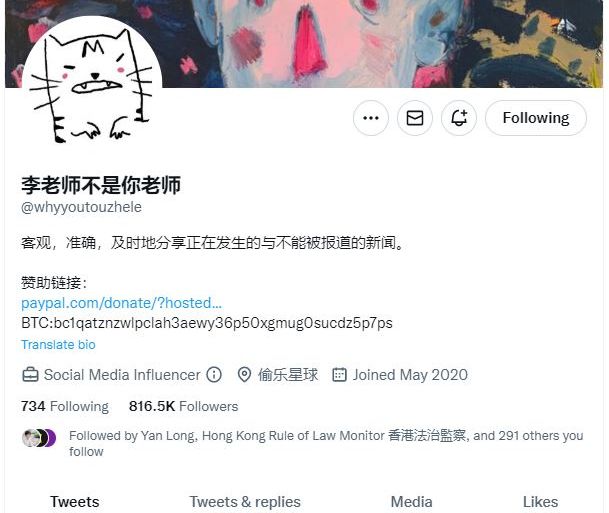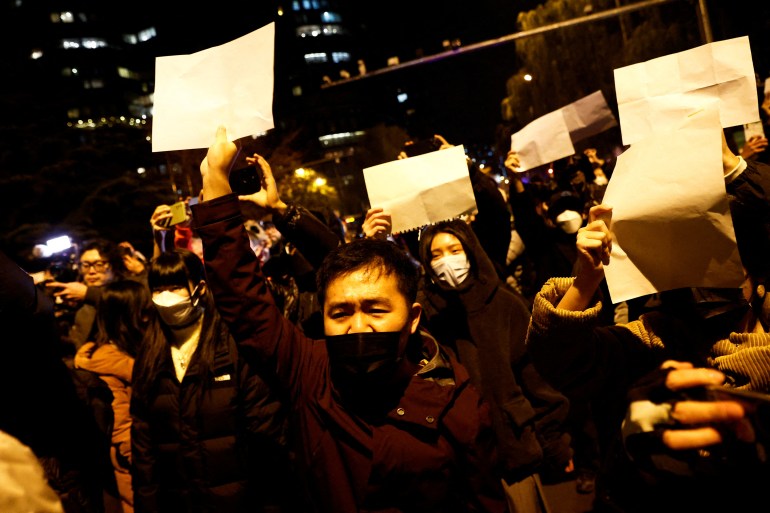How one Chinese Twitter user exposed COVID protests to the world
‘Teacher Li’ has amassed more than 800,000 followers with his posts highlighting COVID-related unrest in China

Taipei, Taiwan – As China faced its biggest protests in a generation last month, one Twitter account played an outsized role in taking protesters’ message beyond the Great Firewall to the outside world.
“Teacher Li is not your teacher”, a pseudonymous Chinese Twitter user based overseas, shared countless videos and images of defiance as protests erupted across the country in opposition to Beijing’s harsh “zero-COVID” restrictions.
Keep reading
list of 4 itemsMusk: Apple wants to block Twitter from its app store
Twitter rolls back COVID misinformation policy
Musk boots Kanye West off Twitter for swastika-Star of David post
The account, which tweets under the handle @whyyoutouzhele, has amassed more than 800,000 followers, most of them in the last fortnight, as journalists, activists, diaspora and amateur China watchers alike have sought to understand the situation on the ground.
The account’s role in the protests has also refocused attention on Twitter’s function as a platform for dissident voices and what future it might have under Elon Musk, who fired much of the social media giant’s workforce tasked with combating misinformation and harassment by authoritarian governments.
“Teacher Li”, as he calls himself, said in an interview he considers his sudden rise to prominence an accident borne of a desire to share the reality of life in China.
Teacher Li, who completed graduate school earlier this year, said he started his Twitter account as a personal outlet focused on everyday musings before moving on to posting about news in China.
Prior to the recent anti-“zero COVID” protests, he had attracted more than 140,000 followers with his insights into the workings of modern China.
But the turning point for Teacher Li came on November 23 when he began tweeting footage of violent clashes between police and workers at an iPhone factory operated by Apple supplier Foxconn in the central Chinese city of Zhengzhou.
Feeling compelled to share as many Chinese social media posts about the protests with the outside world as he could, Teacher Li said he slept just a few hours that day – not realising it was just the beginning of around-the-clock coverage.
After the Zhengzhou protests, a deadly apartment block fire in Urumqi, the capital of the far western Xinjiang region, on November 24 triggered protests across the country after lockdowns – still in place despite the central government’s stated intention to scale back restrictions – were blamed for preventing authorities from responding effectively to the scene.

“Due to the non-stop news coming and new information, I became a follower and gradually began to start recording things from a news-reporting perspective, but I didn’t realise [the protests] wouldn’t end, from Foxconn to Urumqi and then all the big cities across the country,” Teacher Li told Al Jazeera in a video call.
Al Jazeera is not disclosing Teacher Li’s real name or other identifying details such as his location due to concerns he expressed for his safety.
Over time, Teacher Li has refined his approach to using Twitter.
More recent postings feature fewer personal thoughts or observations in favour of fact-based captions that include the date, location, and short summary of the events in the footage or picture.
“When you are reporting, you need to remove your personal feelings about the situation, and you can’t mix in your personal thoughts during this process – actually no feelings or thoughts – because there are too many things that keep happening one after another,” he said.
Teacher Li said he was surprised by the spontaneity of the protests, which have since subsided amid a show of force by authorities, despite claims by the Chinese government that they were the coordinated work of “foreign forces”.
“I am impressed by the change in attitude that everyone has towards the Chinese people. In the past, within the Chinese Twitter community, everyone was generally pessimistic or negative. Everyone thought that maybe something like 89-6-4 [Tiananmen Square] might not happen again because Chinese face such high levels of [social control],” Teacher Li said.
“But this time, it’s beyond the imagination of many people to see so many people taking to the streets … this is the thing that shocked me the most. I didn’t expect to see so many people stand up and bravely shout slogans and fight for their rights.”
Apart from being unusually large in scale, the protests have attracted intense interest as they united people across the country in a common cause against Beijing.
From Beijing to Shanghai and Chengdu, protesters thousands of miles apart used identical slogans and held up blank sheets of paper as a symbol of dissent.
In a number of cases, some protesters not only demanded the relaxation of COVID curbs but also greater political freedoms or the resignation of Chinese President Xi Jinping.
Teacher Li said he has received threatening Twitter messages and been alerted to hacking attempts on his Alipay account and other Chinese apps.
In recent days, at least one copycat account has appeared on Twitter while the genuine Teacher Li account and his handle have disappeared from search results, prompting claims of shadow banning from some supporters. Teacher Li’s posts can be accessed from existing links and his personal Twitter URL is still available.
Teacher Li did not immediately respond to questions about his account disappearing search results, but his posts on Twitter have continued – and along with them hundreds to thousands of “likes” and retweets. Twitter no longer has a communications department.